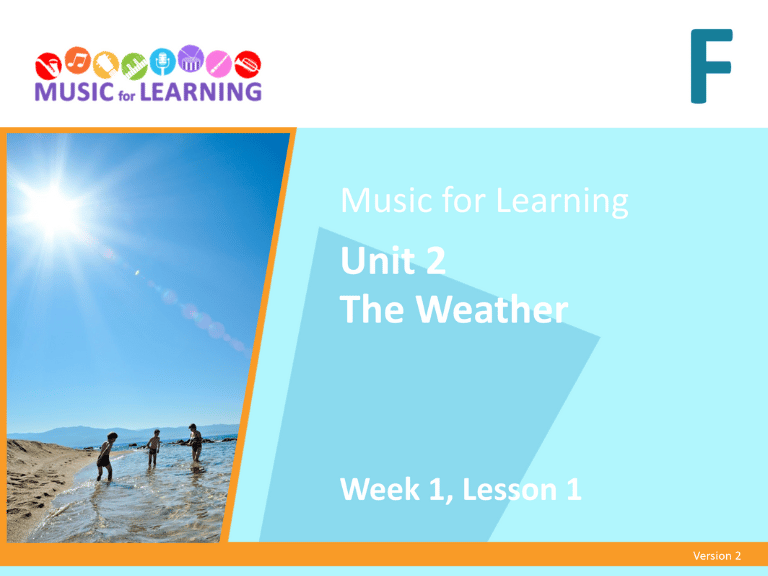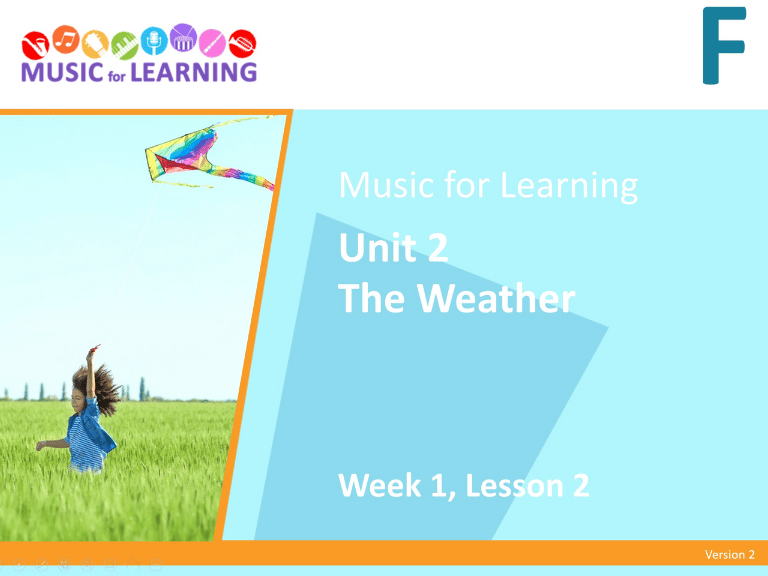Music for Learning - Unit 2
Foundation – Year 6
This unit uses direct and explicit instruction to teach students the fundamentals of music. Through engaging, hands-on lessons built around themes such as travel, sport and culture, students explore rhythm, melody, dynamics and musical expression. With no prior music knowledge required, teachers are supported by structured guides, demo videos and audio resources that make lessons simple to deliver. The unit concludes with students applying their learning to perform and create music with confidence.
Share this page:
Starter Lessons
Unit Overview
Unit Overview
Student Activities and Music
Lesson 1 Series:
- Know that letters, numbers, signs and music notes are all symbols used for reading.
- Learn to sing s and m in tune.
- Learn to show the correct body ladder positions for s and m.
- Learn to notate the rhythm of ‘Rain, Rain’ and ‘Snail, Snail’.
- Learn to tap the beat and clap the rhythm.
- Recognise the rhythm of their own name.
- Learn to compose a rhythm using ta and titi.
- Match simple words to ta and titi.
- Use their speaking voice to memorise and respond to a rhyme.
- Know the ways music can tell a story about the weather.
- Make a rain stick and perform a weather soundscape.
Lesson 2 Series:
- Learn to sing songs about the weather in tune.
- Show the shape of melodies in the air.
- Compose and perform a rhythm using body percussion.
- Demonstrate a strong beat when singing and performing.
- Learn how to sing in different groups in a choir formation.
- Learn and show good behaviours for performing.
- Learn how to rehearse for a performance.
Features
Features
- Creative tasks that allow students to learn by doing.
- Musical examples supporting every lesson.
- Bespoke videos to simplify the learning process.
- Highly engaging visuals and multi-media to support the journey around the world.
Special Inclusions
- Musical examples feature a diverse range of genres and music from around the world.
- Hands-on music-making activities make learning fun and impactful.
- Creative and engaging lessons, making the learning fun and accessible.
- Playing instruments as an integral part of the lessons.
Lessons, Assessment and Resources
Teaching Resources
- 18 PowerPoint lessons with all videos embedded
- Teaching Guide Lesson 1 Series
- Teaching Guide Lesson 2 Series
- Teaching Resources
- Teaching Assessment Book
- Student Workbook
- Student Assessment Book
End-of-Unit Assessment – Lesson 1 Series Only
The End-of-Unit Assessment occurs in Week 8 of the Lesson 1 Series. It consists of a written test of aural and composing skills covered during the unit:
- Choosing the correct rhythm from 2 (aural).
- Choose the correct pitch pattern from 2 (aural).
- Match the word to the rhythmic unit.
- Compose a 4-beat rhythm in beat hearts using ta and titi (see W2 and W5).
Unit Overview
In the ‘Around the World’ unit, students will explore music from a variety of places and cultures. They will learn about various musical instruments, dances, and traditions, while applying their understanding of key musical elements, including pitch, dynamics, duration, and tempo. Through learning songs and rhythms from around the world, students will develop their musicianship and performance skills on voice, keyboard, ukulele, and percussion. The unit will conclude with small group presentations, where students will compose and perform their own pieces, showcasing both creativity and collaboration
Student Activities and Music
Music Examples and Instrumentation
Music examples:
- Instrument sound bites/world music excerpts.
- Raga
- Sakura Sakura
- Che Che Koolay
- Aloha Kakahiaka
Instrumentation: Voice, percussion, ukulele, body percussion and keyboard.
Student Activities
Student activities include:
- listening games, such as guess the instrument: listening to varied musical instruments and identifying the instrument they hear
- performing music by singing and playing in small groups, singing and playing the keyboard and ukulele and by using body percussion.
- improvising on the pentatonic scale
- making Musical Passports that include instruments they have learned about
- movement activities, hula dancing.
Features
Features
- Creative tasks that allow students to learn by doing.
- Musical examples supporting every lesson.
- Bespoke videos to simplify the learning process.
- Highly engaging visuals and multi-media to support the journey around the world.
Special Inclusions
- Musical examples feature a diverse range of genres and music from around the world.
- Hands-on music-making activities make learning fun and impactful.
- Creative and engaging lessons, making the learning fun and accessible.
- Playing instruments as an integral part of the lessons.
Lessons, Assessment and Resources
Unit, Lesson and Assessment Information
- 9 Week Unit
- Lessons are 45 minutes and delivered once a week for nine weeks.
- Summative Assessment, Lessons 8–9: Students will demonstrate their understanding of musical elements by performing music in small groups: by singing and playing keyboard, percussion and ukulele.
Resources
- Lessons x9
- Instructional Teaching Guide
- Musical Passports
- Unit Overview
- Assessments/Progression Indicators
- Professional Learning Modules
Year 3 – Year 4
Unit Overview
In the ‘Music in Sport’ unit, students will explore the different purposes of music in the context of sport. They will consider concepts of community, identity and motivation as they encounter musical examples from around the world. Along with developing their knowledge and understanding of musical elements and compositional devices, students will engage in their own music-making, building their skills on the keyboard to learn simple accompaniments for a range of songs. The unit culminates in a two-lesson project where students will work in groups to create their own team anthem, using the skills they have honed throughout the unit.
Student Activities and Music
Music Examples and Instrumentation
Music examples:
- ‘Simply the Best’, Tina Turner
- ‘Advance Australia Fair’
- Tottenham Hotspur FC Song
- Ghana Black Stars soccer team
- ‘Phambili Nge War’, Bafana Bafana soccer team
- NSW Swifts team song
- ‘Happy’, Pharrell Williams
- Haka, All Blacks rugby team
- Kusun Djembe Drum Circle
- ‘You’re Welcome’ from Moana
- ‘Eye of the Tiger’, Survivor
- ‘We Will Rock You’, Queen
Instrumentation: Keyboard, drums, voice
Student Activities
Student activities include:
- listening to varied musical examples and identifying the musical components that make up the music
- developing basic keyboard skills, including two and three-note chords
- exploring rhythm through drumming and vocal skills
- creating and performing music inspired by the unit’s musical examples.
Features
Features
- Creative tasks that allow students to learn by doing.
- Musical examples supporting every lesson.
- Embedded demonstration videos and audio tracks.
Special Inclusions
- Bespoke audio and video demonstrations support teaching and learning.
- Musical examples feature a diverse range of genres and contexts.
- Hands-on music-making activities make learning fun and impactful.
Lessons, Assessment and Resources
Unit, Lesson and Assessment Information
- 9 Week Unit
- Lessons are 45 minutes and delivered once a week for nine weeks.
- Summative Assessment:
- Lesson 7: A written test reviews the unit’s Exit Tickets and assesses students’ understanding of the key concepts and musical components from the unit.
- Lessons 8–9: Students will demonstrate their understanding of musical components to create a team anthem inspired by the unit’s music examples. Students will make informed choices throughout the creative process and demonstrate their performance skills by presenting their ideas using keyboards, voices and drums.
Resources
- Lessons x 9
- Instructional Teaching Guide
- Student Workbook
- Unit Overview
- Assessments/Progression Indicators
- Professional Learning Modules
Year 5 – Year 6
Unit Overview
In the ‘Contemporary Indigenous Music’ unit, students will explore how modern indigenous artists express cultural identity, storytelling and connection to country through music. They will investigate key artists, songs, and instruments such as voice, guitar and didgeridoo, while developing the understanding of musical elements. Through listening, analysis, and hands-on music-making, students will deepen their appreciation of Indigenous voices in contemporary music. The unit will culminate in a performance of an original piece of music.
Student Activities and Music
Music Examples and Instrumentation
Music examples:
- Marryuna – Baker Boy
- Cape York – Black Image
- Treaty – Yothu Yindi
- Blackfella/Whitefella – Warumpi Band
- My Island Home – Christine Anu
- Fly – Birdz
- Body Percussion – Body Percussion Group
Student Activities
Student activities include:
- listening to contemporary indigenous music and identifying genre characteristics
- analysing contemporary indigenous music using the elements of music
- writing lyrics and developing lyric writing techniques
- performing using rapping techniques, body percussion and beatboxing.
Features
Features
- Creative tasks that allow students to learn by doing.
- Musical examples supporting every lesson.
- Embedded demonstration videos and audio tracks.
Special Inclusions
- Bespoke audio and video demonstrations support teaching and learning.
- Musical examples feature a diverse range of genres and musicians.
- Hands-on music-making activities make learning fun and impactful.
Lessons, Assessment and Resources
Unit, Lesson and Assessment Information
- 9 Week Unit
- Lessons are 45 minutes and delivered once a week for nine weeks.
- Summative Assessment, Lesson 9:
- Lesson 7: A written test reviews the unit’s Exit Tickets and assesses students’ understanding of the key concepts and musical components from the unit.
- Lessons 7–9: Students will demonstrate their understanding of musical components and the contemporary indigenous music context by creating their own composition inspired by the unit’s musical examples. Students will write original lyrics which will be developed using rapping techniques and accompanied by a beat they compose with a partner. Students will make informed choices throughout the creative process and demonstrate their performance skills by presenting their ideas using their bodies and voices.
Resources
- Lessons x 9
- Instructional Teaching Guide
- Student Workbook
- Unit Overview
- Assessments/Progression Indicators
- Professional Learning Modules
Other Units
Lesson Design
Lesson Objective
Success Criteria
Activating Prior Knowledge
I Do
We Do
Apple Question
You Do
Revise
Love what you see? Explore hundreds of FREE lessons in My School Box – join FREE today!








